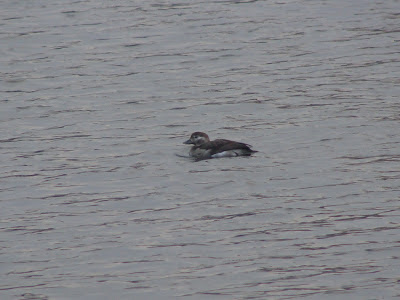After a hectic few months at work came to a successful end on Friday evening, I decided I needed to get out with the bins for a bit. So despite weary limbs I hauled myself out of bed early on Saturday morning for a trip along to Cliffe Pools. A week of bright, sunny mornings had put in the mood for it but as I arrived to heavy, grey skies and patchy rain I wondered whether I should've just stayed in bed. Ah well, I stuck it through and I'm glad I did.
Heading out down the ash track first so as to avoid walking into the rain, it wasn't long before I spotted a horde of familiar shapes up ahead, noisily weighing down the hawthorn bushes along the track -
Fieldfares are back! Horde is the right word as there was a large number of the distinctive scandi thrushes on show. They were flighty but I reckoned on over 250 birds at least, with a fair few starlings in among them, Blackbirds and a couple of
Redwing too. According to the oracle of wikipedia: "the name 'Fieldfare' probably goes back to the 11th Century where the Anglo-Saxon word 'feldefare' perhaps meant traveller through the fields. Alternatively, it may be derived from Old English fealu fearh, literally - grey piglet". I can see how both those might have come to be - you choose. The hawthorn crop looked good so that'll no doubt keep the hungry arrivals happy for a bit.
Down the track chaffinches were everywhere, up to 60, while a Goldcrest called from a tatty clump of hawthorn. Coming out by Flamingo, there were a couple of Reed Buntings calling while several Redshanks titted about on the bank. There were good numbers of birds out on the pool, including 40+ Ringed Plover on the beach and a few
Golden Plover dotted among the greys - the beautiful plumage of these really stood out against their pale feathered companions. I started a vague block count of the
Dunlin at their feet, getting to 400 before they grew restless and began shifting. As several hundred more appeared, some scattered and formed a graceful flock in the sky, passing by me in a rush of wings before swooping over the wall and heading for Essex. I love that sound. A quick scan on the water found a pair of
Goldeneye keeping to themselves.
Around this time last year, I saw Snow Buntings up around the Thames viewpoint on a few occasions but no luck this time. Bar a flock of Avocet crossing from Higham Bight to Essex (and from my position, missing the bow of a tanker by metres) there wasn't much on the river or the jetty so I hugged the wall all the way round as far as Lower Hope Point. A pair of Stonechat flitted among some bramble and a female juvenile Marsh Harrier drifted over the fields on several occasions. On the river side several dozen Curlew roosted alongside more greys and dunlin. Down by the old munitions works what few trees there were were full of fieldfare again and quite a few goldfinches too, some lined up on the sea wall. Out across the marsh a
Merlin zipped by. On the Black Barn pools a few Pintails, my first of autumn, mingled with Shoveler and Lapwing.
Making my way back round by Allen's Pond, the hawthorns again groaned under the number of fieldfares. I reckoned close to 200 birds and almost certainly a different flock from those before. Amazingly one bird stood out quite considerably from the others as it had a totally
white head! I've never seen this part-albino-ism in a Fieldfare before. In with the piglets was a migrant Song Thrush and a few more Redwing.
In 4 hours at Cliffe I saw just one couple walking a dog, otherwise it was just me and the birds. Not a bad couple of hours.
 |
| The invading hordes... |
 |
| Scrub plays havoc with autofocus - Reed Bunting (Emberiza schoeniclus) |
 |
| Cliffe Puddles, 10/11/12 |
RSPB Cliffe Pools, 10/11/12, 0815-1215, Overcast with intermittent drizzle/showers, <10deg, northerly breeze:
Robin, Great Tit, Blue Tit, Fieldfare (c500), Redwing (c10), Blackbird, Starling, Goldfinch, Chaffinch (100+), Greenfinch, Woodpigeon, Reed Bunting (6), Little Egret (3), Redshank, Cormorant, Mallard, Tufted Duck, Greenshank (2), Grey Plover (c150), Golden Plover (3), Ringed Plover (c50), Dunlin (c1800), Lapwing, Black-tailed Godwit, Curlew (c20), Goldeneye (5), Shoveler (c60), Great Crested Grebe, Herring Gull, Great Black-backed Gull, Black-headed Gull, Avocet (c110), Marsh Harrier (1), Meadow Pipit, Skylark, Stonechat (2), Goldcrest (4), Corn Bunting (1 heard), Mute Swan (4 up river), Merlin (1), Mistle Thrush (1), Song Thrush (1), Collared Dove, Rook, Carrion Crow, Wigeon (5), Pochard (3), Little Grebe (c55), Coot, Grey Heron, Pied Wagtail.





















































